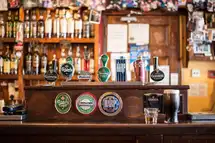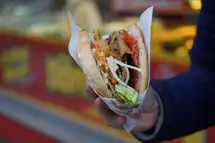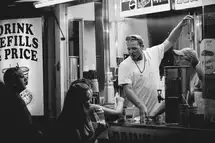What is the national restaurant association?
The National Restaurant Association is an organization that represents the interests of both, the restaurant industry and its patrons. This type of an organization is typically overseen by a board of directors and run by staff members. Its main goal is to create standards for restaurants, including food safety, sanitation, health codes, and performance-based criteria. It also releases research on food trends and what consumers are looking for in terms of their dining experience. With these standards in place, it is able to maintain a healthy, functioning industry with profitability across the board.
A Look Inside the National Restaurant Association- The Industry's Leading Voice
What is the National Restaurant Association?

The National Restaurant Association (NRA) is the apex trade body for the restaurant industry in the United States. It is the biggest such entity in the world. The association represents over 500,000 restaurants and 95% of its members are foodservice businesses.
The National Restaurant Association works to promote government policies that allow foodservice organizations and their employees to exist in a secure and flourishing business climate that is also customer-driven. The association looks to shield foodservice businesses from laws that could potentially jeopardize their economic viability. It also collaborates with 52 state restaurant associations, restaurant industry leaders, and food suppliers to ensure that restaurants are able to do brisk business.
The association brings out comprehensive research reports and analyses, news and press releases, organizes conferences and webinars, conducts training and certification exercises, providing valuable business intelligence information to restaurant owners so that they can sharpen their strategies. It also imparts crucial skillsets to restaurant staff through educational initiatives.
The association also recognizes and encourages quality work in the foodservice sector in the form of awards offered by the National Restaurant Association Educational Foundation, and the National Restaurant Association Show. The National Restaurant Association Educational Foundation provides nearly $1 million in annual scholarships.
The NRA brings together stakeholders to discuss topics covering finance, tax, and audits; food nutrition; food safety; workforce development; information technology; supply chain; and so on. The association also seeks to influence legal and regulatory issues impacting the restaurant industry through the Restaurant Law Center.
This leading voice of the United States restaurant industry has its headquarters in Washington DC.
The National Restaurant Association's History

The National Restaurant Association had its seeds in the egg boycott movement organized by the Kansas City Restaurant Association in 1917. As a result of this movement, egg prices were pushed down to 32 cents a dozen, though egg brokers had been demanding 65 cents.
The success of this movement led the restaurant owners of Kansas City to launch a national body, and in 1919, the NRA was born. The first meeting of this new organization was held in Kansas City on March 13. The NRA, in 1919, represented 43,000 restaurants.
Eight years after it was established, the NRA moved out of Kansas City and set up a base in Chicago. In 1979, it relocated to Washington DC to communicate with the country's lawmakers more effectively.
In the 1930s, the Great Depression swept across the United States. During this time, prohibition, which had started in 1920, was discontinued as a policy. The NRA prepared a Code of Fair Competition as required by Congress's National Recovery Act. Despite those bleak times, the membership of the NRA doubled. The association came up with two innovative slogans aimed at reviving the restaurant industry- 'Take Her Out to Dinner at Least Once a Week', and 'Enjoy LifeEat Out More Often'.
In the 1940s, as the Second World War came to an end, restaurant sales trebled from the level of 20 million daily meals before the war. The NRA unveiled its education department and also produced the film 'America's Heritage of Hospitality', looking to promote the foodservice industry and bring in fresh talent.
The NRA continued to undertake innovative campaigns to propel the industry and boost demand in the 1950s, commissioning two songs- 'Let's Go Out to a Restaurant', and 'Pass the Meat, Pass the Potatoes'. This was the time the concept of fast food came into being with McDonald's 'Speedee System'. The NRA supported the use of credit cards and a new kind of dining experiencethe take-home meals, which families would eat together in their homes, while watching programs on their new black and white television sets.
The 1960s saw restaurants give up traditional French cooking methods as locally-grown produce and new ethnic flavors started to get popular. During this decade, the NRA marked its 50th anniversary.
The association became more active politically in the 1980s as issues like business meal deductibility, tip taxes, tip-reporting rules, minimum wage, and employment law were taken up. In 1981, the Washington Report newsletter and the Restaurants USA magazine were started by the NRA to keep its members up to date with restaurant and food news. The National Restaurant Association Educational Foundation emerged in 1987.
Towards the end of the past millennium, the NRA certified its one-millionth professional as part of its ServSafe food safety program.
Social causes have always been important to the NRA, and in the wake of the terrorist strikes in 2001 and Hurricanes Katrina and Rita in 2005, The NRA mobilized restaurants to participate in Dine for America programs and raised $20 million and $10 million respectively.
Keep up to date with the National Restaurant Association
Subscribe and stay informed about everything restaurant and food related!
How Does the National Restaurant Association Support Restaurants?
Restaurants, whether large or small, independent or chain, confront a variety of issues in Congress, regulatory agencies, and the courts. As the foodservice industry's strongest voice, the National Restaurant Association engages in policy advocacy to ensure that the federal laws and regulations are not inimical to the interests of the restaurant industry.
The National Restaurant Association makes sure that its members are up to date on the most important information.
NRA staff, comprising seasoned lawyers, and regulatory and communications experts, know the requirements of the foodservice industry very well and help the association analyze regulations, and conduct policy advocacy on behalf of the restaurant sector.
The NRA collaborates with state restaurant associations on a daily basis, allowing restaurant owners to concentrate on running their business successfully.
The NRA also offers activities that allow professionals from the Food Service industry to network, discuss best practices, and learn from one another.
The association delivers deep insights into the restaurant industry, keeping members informed about immediate and long-term business conditions. Thanks to regular reports, surveys, and economic indicator analyses, members have ready access to rich business intelligence data so that they can make more data-driven and hence, better business decisions.
The National Restaurant Association and the Educational Foundation's programs expand career prospects in the restaurant sector, assisting a restaurant business to attract talented workers.
Members take advantage of discounts and preferred pricing offers that help protect and promote their business.
The NRA brings together restaurant owners and policymakers through restaurant roundtables to debate regulatory and legislative concerns. On the other hand, the Restaurant Law Center promotes pro-business policies that let businesses expand, generate jobs, and contribute to a strong national economy.
The NRA also provides resources on Restaurant Technologies, marketing and sales, education and scholarships, food nutrition, food and beverage trends, menu labeling, and the ServSafe Food Safety training. ServSafe provides food handler, food manager, responsible alcohol service, and allergen training.
Accomplishments of the National Restaurant Association

1. During the worst days of the epidemic, the NRA and state restaurant associations collaborated to produce and disseminate training instructions, communicate safety initiatives to consumers, and support the workforce.
2. The NRA conceived of the Restaurant Revitalization Fund (RRF), which is worth $28.6 billion. The U.S. Small Business Administration (SBA) administers the RRF, which is a federal grants initiative. This fund is designed to aid small and medium-sized businesses most severely impacted by Covid-19 in regaining their footing. The association is dedicated to assisting all qualifying restaurant owners to apply successfully for grants under the RRF.
3. The NRA secured access to loans under the Paycheck Protection Program (PPP) to the tune of more than $72 billion. The association ensured that forgivable loans could be accessed in a bigger way at a time when restaurants badly needed financing. It worked with Congress to enhance the PPP to fulfill the specific requirements of restaurants.
4. The NRA helped in the establishment of a $21.5 million relief fund for restaurant employees. The National Restaurant Association Educational Foundation was set up the Restaurant Employee Relief Fund (RERF) in collaboration with celebrity chef Guy Fieri. Awards were given under the RERF to over 43,000 restaurant workers.
5. Covid-19 ServSafe instruction courses were created for free. ServSafe's safety experts readily contributed to the designing of Covid-19 training modules, and the free modules have been made use of more than 1 million times.
6. A nationwide television campaign helped in boosting consumer trust in on-premises dining. The association's first consumer advertisement welcomed customers returning to their favorite local restaurants.
NRA and its Effects on the Restaurant Industry

Restaurants were assured of a sum of up to $19,000 for every eligible employee, through Employee Retention Tax Credits (ERTC) in 2020 and 2021, as a result of a change advocated by the NRA.
The association issued a Restaurant Industry Blueprint for Recovery and sent it to Congress, laying out concrete and immediate steps the federal government can take to assist businesses and employees deal with and overcome the Covid-19 situation. The association also created a State Blueprint, urging lawmakers to take steps to help eateries weather the winter and the pandemic.
Restaurants are still struggling to hire and train personnel, prepare payroll, serve communities, and afford food and supplier costs even after nearly two years since the pandemic began. The NRA got many tax provisionswhich would have been tremendously harmful to the restaurant businessremoved from the Build Back Better Act.
The NRA is in favor of immigration reforms that make it easier for American businesses to hire legal workers.
The association, however, voiced its concerns over the Raise the Wage Act of 2021. The Act aims to incrementally increase the national minimum wage by June 2025 to $15 per hour. The NRA said that the proposal would harm small businesses, result in significant job losses, raise consumer expenses, wreak havoc on an industry still recovering from COVID-19, and put an end to tipping, which consumers and servers favor.
Furthermore, according to the NRA, 177,000 qualified eateries have filed for RRF subsidies but have not received them yet. The total amount of unfunded applications is $43.6 billion. The association is conducting a legislative outreach campaign to bring members of Congress abreast of the latest economic data and convince policymakers about the need for RRF replenishment.
Your one stop shop for the latest news
Subscribe and stay informed about everything restaurant and food related!
Objectives of the National Restaurant Association

The NRA looks to create a robust foodservice industry that provides nourishment, opportunity, and joy to Americans while also working to improve everyone's quality of life. The National Restaurant Association's objective is to support the restaurant industry by strengthening foodservice operations, reducing risk, developing talent; advancing and protecting business vibrancy through advocacy at the national, state, and local levels; and fostering knowledge and collaboration.
The NRA looks to protect the restaurant industry from harsh laws and communicates with the powers that be to present the perspective of the foodservice industry to the policymakers. The association also seeks to impart training in food handling and food safety. Training involves the identification of the food safety Danger Zone, among other things.
The NRA also provides restaurant operators with Food News and trends, and hence, assists them in making better decisions. The NRA's instructional resources help members establish a productive workforce. The ServSafe program ensures a harassment-free and safe work environment.
The association collaborates with state restaurant associations to provide products and techniques to its members to help them grow their businesses. It aims to establish foodservice sector standards in areas such as Food Safety, hygiene, and so on.
A Look Inside the National Restaurant Association

The National Restaurant Association is administered by a Board of Directors made up of executives from all sectors.
Lance Trenary is the current Chairperson, while Scott Redler is the Vice Chairperson. The post of Treasurer is held by Jeff Lobdell, while Brian Casey is the Immediate Past Chairperson.
Other senior executives of the NRA are Marvin Irby, Interim President and CEO; Kevin Steele, Chief Information Officer; Rob Gifford, President, National Restaurant Association Educational Foundation; Chris Rodgers, Executive Vice President, General Counsel and Corporate Secretary; Sherman Brown, Executive Vice President, Training and Certification; Sean Kennedy, Executive Vice President, Public Affairs; and Tia Mattson, Executive Vice President, Enterprise Marketing and Communications.
The National Restaurant Association's principal funding source for promoting and defending the restaurant sector is the Restaurant Advocacy Fund (RAF).
The association collaborates with government agencies to make sure that restaurant businesses share distinct stakeholder viewpoints on laws that are frequently complex. It works with local governments to help legislators understand the restaurant sector's economic impact and contributions.
The NRA gives Congress unmatched industry expertise and perspective on economic trends, legislative initiatives, and business conditions.
The NRA gives entrepreneurs valuable Business Intelligence data on the latest trends in the foodservice industry, and NRA economists offer analysis of trends that may influence restaurant businesses.
The Kids LiveWell program, which was created using the most up-to-date Food Nutrition science, makes it simple to promote meals that are better for children and their parents.
Find out more about the restaurant industry's top organization
Subscribe and stay informed about everything restaurant and food related!














































































































